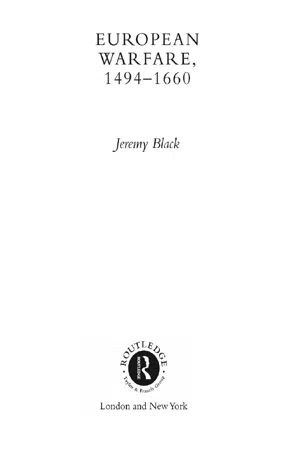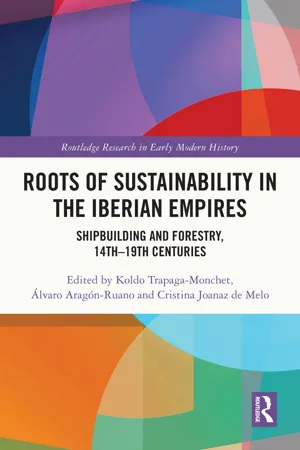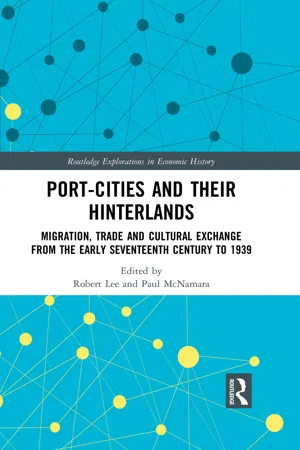History
Portuguese Maritime Technology
Portuguese maritime technology refers to the advancements and innovations in shipbuilding, navigation, and maritime exploration developed by Portugal during its Age of Discovery. This period saw the development of caravels, improved navigational instruments, and the establishment of trade routes to Africa, Asia, and the Americas. Portuguese maritime technology played a crucial role in shaping global exploration and trade during the 15th and 16th centuries.
Written by Perlego with AI-assistance
Related key terms
Related key terms
1 of 4
Related key terms
1 of 3
3 Key excerpts on "Portuguese Maritime Technology"
- eBook - ePub
- Jeremy Black(Author)
- 2005(Publication Date)
- Routledge(Publisher)
Initially, the most impressive naval power was Portugal. Her naval strength was based on sailing ships which were strong enough to carry cannon capable of sinking the lightly-built vessels of the Indian Ocean. Their heavier armament was crucial in the face of the numerical advantage of their opponents. Drawing on late fourteenth and fifteenth-century developments in ship construction and navigation, specifically the fusion of Atlantic and Mediterranean techniques of hull construction and lateen and square-rigging, and advances in location-finding at sea, the Portuguese enjoyed advantages over other vessels, whether they carried cannon or not. Developments in rigging permitted greater speed, improved manoeuvrability and a better ability to sail close to the wind. Information played a major role. Thanks to the use of the compass and other developments in navigation, such as the solution in 1484 to the problem of measuring latitude south of the Equator, it was possible to chart the sea and to assemble knowledge about it, and therefore to have greater control over the relationship between the enormity of the ocean and the transience of man than ever before.Portuguese naval strength was based on full-rigged sailing ships which were strong enough to carry heavy wrought-iron guns capable of sinking lightly-built vessels. The Portuguese fleet was a state-owned and controlled body.The ships were built in the royal dockyards at Lisbon and Oporto, but, as with the Spaniards at Havana, the Portuguese also discovered the value of developing colonial dockyard facilities. This was useful both for constructing vessels from durable tropical hardwoods, like western Indian teak, and for repairing warships locally. The Portuguese built a large 800-tonne ship at Cochin in 1511–12, established a major dockyard at Goa in 1515, and developed ship-building facilities at Damao and Macao. A key element in the Portuguese expansion along the coast of Africa and into the Indian Ocean was its string of fortified naval bases.They replicated the role of the ports that were so indispensable to Mediterranean galley operations, but over a vastly greater distance. Portuguese sailors knew that they could replenish in safety at a series of ‘way stations’ on their long voyages to and from Asia.Their ‘sea lines of communication’ rested on their bases, a policy that the Dutch and English copied in the seventeenth and eighteenth centuries. Cape Town was developed by the Dutch as an area to grow green vegetables to replenish their ships sailing to and from Asia. - eBook - ePub
Roots of Sustainability in the Iberian Empires
Shipbuilding and Forestry, 14th - 19th Centuries
- Koldo Trapaga Monchet, Álvaro Aragón-Ruano, Cristina Joanaz de Melo, Koldo Trapaga Monchet, Álvaro Aragón-Ruano, Cristina Joanaz de Melo(Authors)
- 2023(Publication Date)
- Routledge(Publisher)
During the centuries of the Early Modern Age, which are referred to as the first global age (16th–18th centuries), shipbuilding was an industry that was closely linked to the development of empires. Shipbuilding techniques evolved and were perfected in terms of technology. The ships that were to be used for sea exploration were improved, as was the design of warships and merchant vessels. The organisation of ships also underwent great improvements. This development was important for the Iberian Empires, who were pioneers in shaping the Atlantic world of political, cultural, economic and social interaction. Together with the new landscape opened up by Spain and Portugal, the socio-cultural, technological and economic interaction in which these powers engaged, particularly with the maritime powers Holland and England, means that our analysis should also be undertaken from a comparative viewpoint.We should also bear in mind the technological transfer that took place in a far more connected and “entangled” world, as previous studies have suggested. In fact, there was all the more interference and transfer of technological and economic knowledge thanks to the constant migration of manual labour specialising in tasks that were linked to trade and the naval sector. This may be clearly concluded from studies on the naval architecture of different periods and different geographical locations. The transfer of technology in the field of shipbuilding, differences between theory and practice as seen in archaeological evidence, and the notion that shipyards and arsenals were key centres for experimentation are all matters still awaiting further research, despite the studies already carried out on shipyards. It is in these valuable studies that we can really visualise the continual process of experimentation and knowledge transfer, in particular of scientific knowledge (already studied for the 18th century in particular). Key examples include the mutually influential relationship between Spain and England and the French influence seen in Cuba. Of these studies, that of Quintero González is the one that has explored in the most detail topics relating to the timber used in boats from a historical viewpoint.33 - eBook - ePub
Port-Cities and their Hinterlands
Migration, Trade and Cultural Exchange from the Early Seventeenth Century to 1939
- Robert Lee, Paul McNamara, Robert Lee, Paul McNamara(Authors)
- 2022(Publication Date)
- Routledge(Publisher)
103–109. Ports and shipping were of outmost importance in the projection of the Portuguese late medieval and early modern economy. Northern Portuguese seaports were very dynamic in this field and provided extensive services and support for international shipping. There is abundant evidence of ships leaving from Portuguese ports and then spending long periods away before returning to their home base having spent that time on successive voyages in the service of Flemish, Italian, Catalan, English merchants, etc. In the Middle Ages seafarers rose to prominence in the city of Porto. Some members of the Council owned ships, often on a partnership basis which by the fifteenth century was the standard way in which ships were owned and operated. For instance, when northern European competitors disrupted the Portuguese sugar trade, Porto was able to counter this by focusing its business on wine or salt. Both suburbs and hinterlands were integral elements in the city’s development. The construction of additional town walls in the fourteenth century, in addition to new port structures, which were instrumental in its modernisation and the increase in national and international trade, had a number of ramifications. They signified an expansion of the urban core; led to the creation of new administrative areas (boroughs) inside the extended urban perimeter ‘gained’ from the original suburbs; and was accompanied by the establishment of new peripheral areas once distant from the town’s centre. This process was evident on a continuing basis as older suburban districts were gradually integrated into the urban core, including the boroughs of Miragaia, Massarelos, Cedofeita, and Santo Ildefonso during the Early Modern Period
Index pages curate the most relevant extracts from our library of academic textbooks. They’ve been created using an in-house natural language model (NLM), each adding context and meaning to key research topics.
Explore more topic indexes
Explore more topic indexes
1 of 6
Explore more topic indexes
1 of 4


